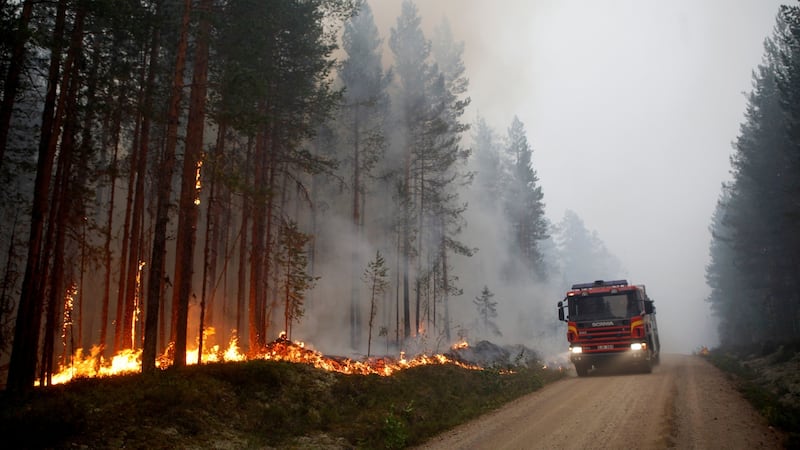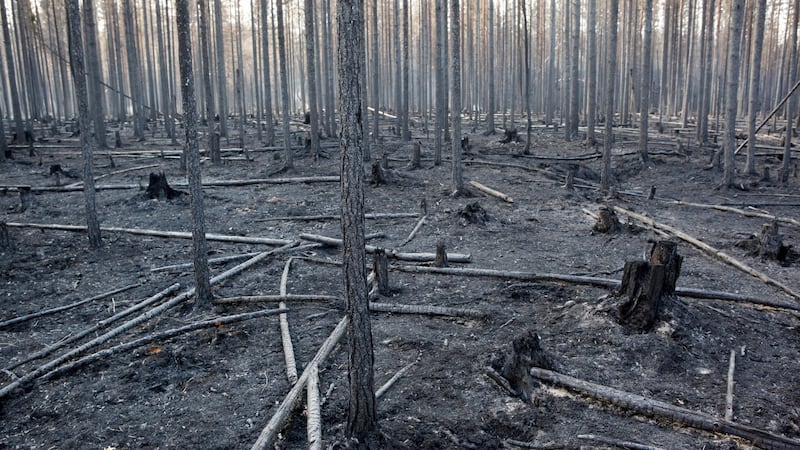Sweden is experiencing the most serious and extensive forest fires in its modern history. Huge swathes of land, mostly forests but also heathland, all across the country, right up into the Arctic Circle and out to the Baltic, have been blazing. On the front line, firefighters are dealing with temperatures of 800-1,000 degrees Celsius. The Swedish government has called for international assistance from the European Commission: reinforcements have been supplied by the Italian, French, Norwegian, Danish, German, Lithuanian and Polish governments. A colossal crisis response is in operation. It is unprecedented. Heatwave Lucifer has arrived.
Ljusdal, which I roughly translate as “the valley of light”, is one of the most affected areas. Fire has destroyed or is affecting a swathe of land which in our own context would burn a corridor at least 10km wide, from Lisburn, the greater Belfast area, including the north and south foreshores of Belfast Lough all the way to Holywood and Bangor. It might well get worse.
It is most likely the fires were started by lightning striking tinder-dry forests. Some villages have been evacuated. Reports indicate that the authorities think they cannot hope to extinguish some of the fires – they will need to be contained, if possible, and burn themselves out. Planes and helicopters are being deployed. Emergency teams are culling huge quantities of trees to create 60m wide corridors, perhaps 8-10km long in the hope that they are adequate barrier zones to prevent the fire from spreading further. A radio reported the fire is advancing at speeds of up to one metre a second. Think about that – 60 metres a minute.
A few days ago, we woke to the smell of wood-smoke – a smell we usually associate with winter. The small wild birds clustered frantically at the bird table we use to feed them in winter. Amongst the trees, smoke. The whole valley was filled with the smell. The nearest fires to us were 70km or so south of Ljusdal, and yet the scale is so marked that we could taste and smell the burning wood.

This is Hälsingland – it is unlikely most Irish people have heard of it. To get there, leave Stockholm, cross the extensive plateau around Uppsala, and eventually, roughly 300km northwards you cross a bridge over the river Voxnan. Suddenly the whole landscape changes to something entirely other – this is a portal to Norrland, the northern part of Sweden. Hälsingland is a rural Swedish county, approximating in size to the six counties of the north of Ireland. If this place has any resonance with anywhere in Ireland, it is with Fermanagh, my home county. It is a place of trees, lakes, small towns. The people are practical, friendly, unassuming.
The houses are mostly made of timber, and they are mostly painted with red paint; at home we call it "red lead". Outside of the towns, houses are scattered across the landscape in farms, often just one or two storeys high, occasionally three storeys. There are clusters of timber buildings, harmonious and mirroring each other, so that the barns, and the cattle sheds, the houses for people, the playhouses and boat houses, the woodsheds, right down to the stables, dog-houses and bird-tables, are replicas of one another. Everything harmonises. Everything has a place. There has always been a sense of enough. Nothing excessive – enough. The Swedish even have a word for just this: lagom.
In general, nothing much happens. It is simply beautiful, and beautifully simple. The place and the people don’t over-reach, are not pushy, nor flashy and don’t seek attention – to do otherwise is “un-Swedish”. It is just a pristine natural environment of lush pasture, lakes and forests. The attitude to life is patient, unhurried, reflective. The invitation to the interloper is to be present, though it will never be said out loud. It doesn’t need to be – the people and the place evoke it. It is just the way of things. Nature is loved. Wildflowers are abundant. Bearded lichens are on the trees. Other lichens grow so slowly on rocks, it takes them hundreds of years to mature. Water purity is of the highest priority – with everyone. Bears, moose, lynx, wolves live in the forests. The climate is optimal for growing the very best pine – the trees thrive in temperature differentials oscillating across lengthy winters of deep coldness, followed by warmer days in summer when there is always some light in the sky. Autumn and spring are generally intense, but relatively short transitions in the year.
The weather this year has been so strange. In March, there was still a heavy fall of snow, up to 4ft, considerably more than normal. The winter was long and harsh but the neighbours say that the shift to summer was sudden; there was no spring. The temperatures suddenly rose to 25 degrees or so, the snow melted and since then there has been hardly any rain. In Stockholm many of the deciduous trees such as birches are already fully in autumnal mode, in July – their leaves yellowed and falling.
Hälsingland is not overly touristic although Unesco has designated some farmhouses as world heritage sites. The neighbouring houses to us include an old traditional farmhouse from the 1700s. It is still with the same family. That family is not unusual. These are just good, unpretentious, honest people, living close to the land, as they have done for generations. It is a community that is intact, characterised by a profound sense of uninjuredness, in contrast to my home county or anywhere in the North really. Hälsingland doesn't market itself heavily as a place for tourists, though it could, if it wanted to. Instead it is low-key and natural. Walk in the forests, swim in the lakes. Go cross-country skiing in the winter. Gather the berries. Collect the mushrooms. Be. It is enough. Lagom.
I have been coming here for several years with my husband. He is a Swedish national, and in common with most Swedes, he keeps a modest summer house. It is his connection to his home country, to a small community and a place he belongs to. It is such a place as he has been coming to since he was a small boy, having grown up mostly in the suburbs of Stockholm. We sleep well; the air is pure. I spend many hours sprawled on the sofa in the kitchen, just gazing at the sky – the high dome, clean and expansive. It is another world.

Days pass in unfussy ways – we tend the lawn, repair things in the house, cook simple food, read, go for walks, swim. The water is clear and pure; stepping into it fractures the reflection of blue skies. Look down and the colours in the water are amber, ochre, gold, honey, peat. There are ruddy tones but also lime green, leaf-green, bottle green, because the lake is also surrounded by trees. It is fresh and bracing – in the winter it freezes over, and the chill persists in summer – the coldness of the water keeps the brightness of winter in it.
The best pine trees take 60-70 years to mature. These forests were planted two or three generations ago by people who would never benefit themselves. In equivalence, this would mean, my great-grandmother, a woman born in the late 1800s, planting trees in her mature years, for me three generations later to be the beneficiary. It would mean me, a woman in my fifties, planting trees now, for the benefit, not of my own children, nor theirs, but for the generation beyond, to harvest in their adulthood. Trees are the inheritance and the through-line.
Nature is everything to Swedes – Stockholm is full of trees in the archipelago of islands which constitute the city. Here the water is so valued, so protected and so clean, the citizens have full access to it, to swim, for kayaking, to sail, to fish in. I can’t think of another city in the world I have been to, where the environment has been so integral, preserved and respected.
It is unlikely the fires were started deliberately. It was a Swede who invented the ultimate contradiction – the safety match, and besides, forests are deeply embedded in the Swedish psyche. Allemansrätten, the right to roam and to forage in the forests, is a legal protection that enables everyone to have right of access to forests. The mythology, the songs, the stories, the literature of Sweden all begin in the forests. Assemblages of moss, mushrooms, berries and trolls are common traditional Christmas decorations. I apologise for mentioning the "C" word in July, but I am making a point to emphasise that the forest is mother, father and everything in between, in the psyche of the Swede. Fires therefore carry an additional ability to wound. This is traumatic and catastrophic and intergenerational.
At the time of writing, the Swedish government calculate the value of forest that has been lost will exceed 700 million Kr (€70 million). The fires are burning from the Arctic to the Baltic. Within the Arctic Circle, at Abisko on July 18th, the temperature reached 33 degrees Celsius. The historical average is 17 degrees. There are fires of forest and heath within the Arctic Circle. Even the Arctic is burning.
Swedes are practical and self-sufficient. Their default response to complexity is to be factual, cool-headed, comprehensive. They are not alarmist nor prone to hyperbole. There is a system for everything, and the system tends to work. It is most unusual that they ask for help – so when they do, the rest of us ought to pay attention.
Swifts scream overhead. In the early morning I hear the forlorn calling of the migratory cranes towards the south. It is desolate, melancholic. Something has changed forever. Radically. Catastrophically. This is far from over.
Maria McManus is a poet. Her most recent collection, Available Light, was published by Arlen House (2018). She co-ordinates and curates the Poetry Jukebox












